|
Get your Season 10 bass submitted by October 15!
As we continue to monitor impacts from Hurricane Ian, we remind anglers to stay safe. TrophyCatch Season 10 is now over, and the clock is ticking to submit catches caught between Oct. 1, 2021 and Sept. 30, 2022! Anglers have until Oct. 15 to submit all TrophyCatch bass in order to claim prizes! This same day (10/15) is also the deadline to report any captured pink tags as part of our 10-tag promotion, too. (Shown is Luis Call-Neumann with an Orange Lake 10-pounder.)
As this quarter drew to a close, submissions continued to flood the TrophyCatch Inbox. Program totals through mid-September are:
- 10,725 Lunker Club (8-9.9 lbs.)
- 2,691 Trophy Club (10-12.9 lbs.)
- 133 Hall of Fame (13+ lbs.)
- 13,549 TOTAL approved submissions to date
Not bad at all as TrophyCatch winds up a decade of bass celebration and conservation!
To continue to keep up more frequently with TrophyCatch, make sure you like and follow the TrophyCatch Facebook page, and for all freshwater news, follow FWC Freshwater Fisheries Instagram!
Follow us on Facebook and Instagram to stay in the know!
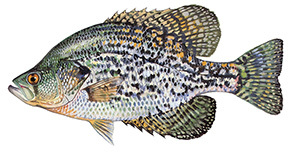
Size: This fish averages just under one pound; the state record is currently 3.83 pounds. The Big Catch minimum qualifying sizes are 14” or 2.0 pounds (see BigCatchFlorida.com).
Appearance: The black crappie’s distinct black-and-white patterning, symmetrical back (dorsal) and belly (anal) fins and flat panfish shape make it easy to identify. The only other species that might cause some confusion is the nonnative jaguar guapote found in south Florida, which has a divided lateral line and sharp teeth that distinguish it from our native black crappie.
Range & Habitat: Black crappie are common throughout Florida lakes and ponds, or in large slow-moving clear water rivers. Lake Okeechobee is the best-know "speck fishing" destination in the state.
Behavior: They nest in colonies from February to April. Nests are fanned by males over gravel or muddy bottoms in depths of 3-8 feet, with big fish deeper. Primary food items are crustaceans, aquatic insects and small fishes.
Sporting Quality: Most Florida anglers are quite familiar with black crappie, also called “speckled perch” or “specks”. This fish follows on the heels of the largemouth bass for popularity in the fresh waters of our state. The crappie is not quite as easily found or as widespread as the bass, however. Specks do best in larger lakes, particularly if deep water and cover—especially brush—are present but are less common within canals. Crappie make ideal cane pole or light tackle targets. Missouri minnows are the bait of choice. Lure anglers usually stick with small marabou or curlytail jigs, with white, yellow and black being good starting colors. Beetle spins of various colors also work well. Fly anglers can do well with small streamers but will need to use a sinking line to get down to the fish. Set the hook gently, as the soft mouth (which has resulted in the nickname “papermouth”) can result in missed strikes. This fish fights well and performs even better on the table. A key to success is to fish at different depths and keep moving until you find a school. Once located, large numbers of “specks” can often be caught within a short period of time.
Fish illustration by Duane Raver, Jr.
|
 |
The versatile kayak can get you closer to bass!
This issue continues looking at the incredibly adaptable kayak, focusing on accessories that will make your paddling and fishing a success.
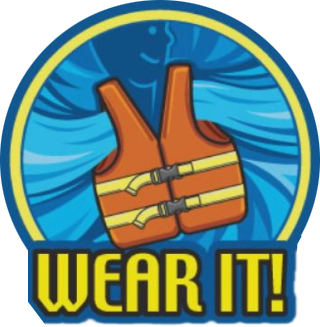
Personal Flotation Device (PFD): Your number one accessory is your life vest, or PFD. Inflatable PFDs offer coolness and light weight, although many kayakers will tell you that you’re going to tip over (and activate the CO2 cylinder) sooner or later. Make sure you are also complying with all other boating safety requirements. Another “must have” accessory will be a dry storage bag for keeping your phone, electronic car keys, camera and other sensitive gear safe from the elements or dry in case of a rollover.
|
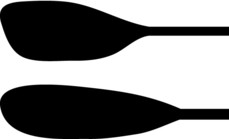
Paddles: Kayak paddles are double bladed, unlike rowboat oars or canoe paddles. This makes the kayak an extremely efficient craft, because you propel it with both the forward and what otherwise would be the “back” stroke. Paddles come in specific shaft lengths, which you choose based on the width of your kayak and your height. The wider your kayak and the taller you are, the longer paddle shaft you will need. Kayak and paddle manufacturers provide tables for making your best choice. Paddle blades also vary. A long narrow blade works well for propelling a kayak nonstop over long distances, while a short broad blade works well for tight maneuvering along brushy shorelines and the stop-and-go travel a kayak angler will likely be making. In Florida’s lakes and ponds, most anglers should stick with a broad blade. As a side note, be aware that some fishing kayaks are equipped with various pedal-and-propellor systems that make propulsion a lot easier and leave your hands free for fishing. These are nice, but significantly more expensive, and are generally restricted to longer and heavier kayaks.
|
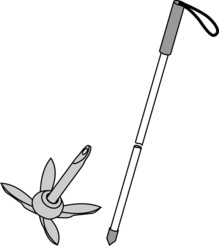
One of the factors to be aware of when fishing from a lightweight kayak is that it is easily pushed around by wind or waves, so you’ll want a lightweight folding anchor to help you stay put. An anchor works best in deeper water or when you’ll be staying put for a little while, such as when fishing bait. If you use the anchor a lot, you’ll want an anchor trolley that allows you to position the anchor line fore or aft, depending on wind or current and how you want to position your craft. For frequent moving and anchoring—which I’ve found to be the norm for lure fishing—a stakeout pole is much more convenient. This is simply a pole pushed into the lake bottom to anchor the kayak. The pole can be inserted through a scupper hole or attached to the kayak with a short rope and snap clip. Many anglers prefer a stakeout pole over an anchor because there’s less chance of tangling with a scrappy fish. You can buy a commercial stakeout pole or make your own out of PVC pipe or any other sturdy pole such as an old golf club with the head removed. Use is obviously limited to fairly shallow water, depending on the length of the stakeout pole.
|
If you are going to have to carry your kayak any distance between your parking spot and the water, consider buying a wheeled kayak carrier. These handy little carts strap onto the bottom of your kayak, allowing you to roll your craft to the water. An advantage of these is that you can load all your equipment into the kayak and make a single trip, rather than going back and forth to your vehicle. Strapping the wheels in place near the kayak’s center of gravity will provide a balanced and effortless walk to the water’s edge. Some kayak manufacturers offer carts that will fit right into their kayaks’ scupper holes, eliminating the need for straps.
There’s a host of other accessories available: extra or specialized rod holders, rod and paddle tethers, depth finder and camera mounts, special kayak tackle holders, baitwells, and more. Kayakers (and kayak manufacturers) seem to be a particularly inventive lot! Customizing your kayak for your comfort and specific fishing needs can not only put more fish in the boat, but also be a satisfying end in itself.
Next issue will wrap up with taking care of your kayak and actually fishing from it.
A nice "Lake Pan" eight-pounder sampled by FWC biologists.
Size: 4,460 acres
Location: Sumter County
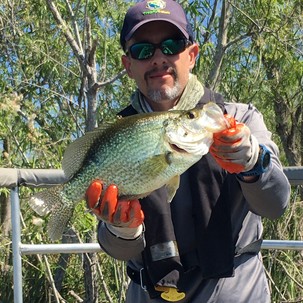
Description: Over the last two years, Lake Panasoffkee has become one of the best bass fishing lakes in the FWC's Northeast Region. Winning weights in bass tournaments are routinely in the 25-30 lbs. range with bass over 8 lbs. becoming more common. The northern end of the lake consistently has the clearest water and abundant eelgrass making it a popular area for sight fishing and casting soft jerkbaits. Emergent vegetation in the middle of the lake along the eastern shoreline indicates areas with shallower shoals. These areas consistently produce good numbers of bass. When the sun gets high, anglers have success punching matted vegetation with heavy Texas rigs. The southern end of the lake tends to be heavily stained with less submersed vegetation, making this a good place to look for black crappie (inset photo). This past year was one of the best years ever for crappie fishing on the lake. Try trolling small crankbaits or road runners in open water. Panasoffkee has historically been known for quality bream fishing. Cover water until you smell the bream beds. Then set anchor and cast grass shrimp or crickets under a float for bluegill or stumpknockers (spotted sunfish) or switch up to red wigglers for redear sunfish. Pana Vista Lodge and Tracy’s Point provide good boat launching access along with tackle shops. Habitat restoration work, in the form of tussock removal from 2006 through 2008, opened up a lot of water along the eastern shoreline. This is an area where deeper water can be found close to the shore making it a good area to look for bass and crappie.
|
 |
|
One of the most important factors fisheries biologists must determine in order to fully understand a fish population is its age structure. This includes knowledge not only of how old individual fish are, but what percentage of the population makes up each different age group. |

Aging fish is based on the principle that fish grow at a slower rate during the winter when cooler temperatures slow metabolism. In body parts (such as scales or bones) where growth layers are laid down, winter growth layers will be spaced more closely together than warm-weather, fast-growth layers. These narrower and closer layers, as a group, will appear as a single dark band, while the wider and more broadly-spaced growth layers laid down during warm weather will appear as a single light-colored band. Each light and dark band represents a single year’s growth in a fish’s life. This is the same basic principle as counting rings on a tree.
|
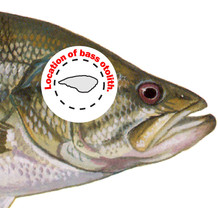 |
|
This light/dark contrast will not be as distinct in Florida’s warm subtropical climate as it would be in much colder northern states, and certain body parts (scales, spines, and certain bones) are more reliable for some species of fish than for others. In our mild Florida climate, ear bones called “otoliths” have been found to be the most reliable for aging largemouth bass. These earstones are located within the skull and are important to the fish for sound and vibration detection. |
When properly sectioned, these otoliths can reveal growth rings (called “annuli"), below. A very thin slice is carefully cut from the otolith using a fine jeweler's saw and the cross section mounted on a microscope slide. At 100X magnification, the growth rings can be counted (or “read”) and the age of the fish determined.
Counting the rings, or annuli, on an otolith takes experience and a sharp eye — especially when looking at something so small, even under a microscope! The fish this otolith drawing was made from was 5 years old. Much research on Florida largemouth bass has shown that on average, bass grow about one pound per year. So, a 10-pound bass is probably about 10 years old. However, depending on available forage, temperature and other growth conditions the age range of a bass that large could vary from only 4 years old (fast growth rate) to 16 years old (slow growth rate).
To contact the Florida Freshwater Angler, email John Cimbaro. Fish illustrations by Duane Raver, Jr. and Diane Rome Peebles.
|